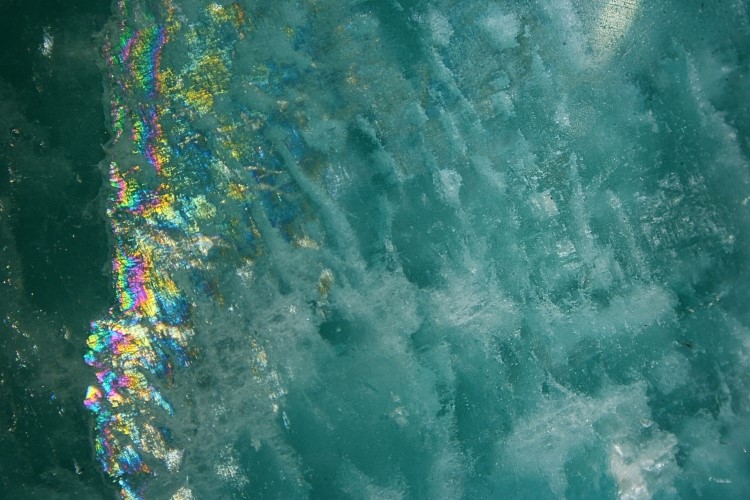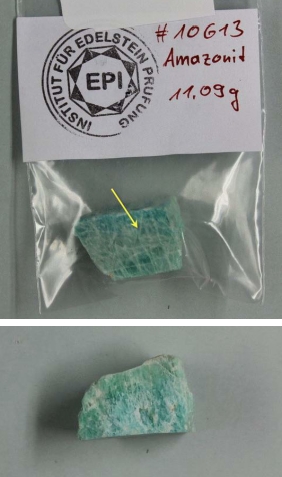
The color of Amazonite is based on 3 components: lead, water and radiation..
Foto: K. Sieber, www.makrogalerie.de
Minerals are chemical substances formed by natural processes. In contrast to the artificially created, solid chemical compounds (chemicals), which are mostly produced in form of powders , the minerals that are interesting for mineral collectors and jewelry lovers are crystallized in a clearly visible macro size. Minerals may - just like industrial products - carry heavy metals and other elements which under certain circumstances can have a harmful effect on human health or the environment.
As long as a mineral - with the exception of radioactive minerals - is only placed on the windowsill and looked at, its ingredients can usually be ignored. The important thing is not what is inside a mineral, but what is released into the environment and absorbed by the human body.
In recent decades, the use of minerals has expanded significantly. In the past, the purely optical, aesthetic aspect or scientific interest was the main motivation to deal with minerals. Today minerals are also used for wellness applications, cosmetics and as healing stones. Also the insertion of minerals for several hours and days in oils or drinking water for the purpose of energizing or wellness is a new application of minerals, which was largely unknown 30 years ago.
From this changing user behavior, new ways of migration of harmful elements from the mineral into the environment and into the human body are emerging. One of the services of the EPI laboratory is to identify potential hazards in these new ways of handling minerals and to provide advice on safe handling.
In order to be able to assess a possible health hazard, we have found a clearly defined, reproducible method in the so-called "Toys Directive" EN-71-3 to measure how many mg of a certain element a stone releases under certain conditions. This standard EN-71-3 specifies the maximum amount of heavy metals and other potentially toxic elements such as aluminum, boron or barium that may be released by a preparation under certain clearly defined conditions, so that it is safe in children's hands.
For this purpose, the sample is stored in a saliva-like, acidic aqueous solution for about one hour to simulate children putting objects into their mouths or swallowing them. Afterwards, Inductive Coupled Argon Plasma Spectrometry is used to measure how many mg of heavy metals per kg of sample substance have been released into this solution.
When testing amazonite according to the procedure just described, we obtained the following data:

Fig. 2: Used sample material #10613
|
Element |
Unit |
Results |
Limits according to |
|
|
Aluminium |
Al |
mg/kg |
11 |
70000 |
|
Antimony |
Sb |
mg/kg |
< 10 |
560 |
|
Arsenic |
As |
mg/kg |
< 1.0 |
47 |
|
Boron |
B |
mg/kg |
< 10 |
15000 |
|
Barium |
Ba |
mg/kg |
< 10 |
18750 |
|
Cadmium |
Cd |
mg/kg |
< 1.0 |
17 |
|
Cobalt |
Co |
mg/kg |
< 10 |
130 |
|
Chrome (total) |
Cr |
mg/kg |
< 0.2 |
460 |
|
Chrome VI |
Cr6+ |
mg/kg |
< 0.02 |
0,053 |
|
Copper |
Cu |
mg/kg |
< 10 |
7700 |
|
Manganese |
Mn |
mg/kg |
< 10 |
15000 |
|
Nickle |
Ni |
mg/kg |
< 10 |
930 |
|
Lead |
Pb |
mg/kg |
125 |
23 |
|
Selene |
Se |
mg/kg |
< 10 |
460 |
|
Tin |
Sn |
mg/kg |
< 1.0 |
180000 |
|
Strontium |
Sr |
mg/kg |
< 10 |
56000 |
|
Zinc |
Zn |
mg/kg |
< 10 |
46000 |
|
Mercury |
Hg |
mg/kg |
< 1.0 |
94 |
The data show that the amount of leaked (migrated) lead (125 mg/kg) exceeds the maximum permitted level (23 mg/kg) by approximately five times. Thus, the sample was unsuitable as a children's toy and would not have been approved as a children's toy in the EU. Under which conditions and in which way lead can affect health and the environment, you can read in our article Toxic Minerals.
How to evaluate these data?
When evaluating statistics or data of any kind, it is immensely important to know and consider the frame of reference of the data collection. For the correct classification of the Amazonit evaluation results the following is important:
1. the data were collected from a stone (see Fig. 2) that was stored for a time in an acidic environment. However, drinking water is neutral. Therefore it is to be expected that the emission of lead from amazonite into drinking water in the given time is rather smaller than under the experimental conditions under which the data were collected.
2. the time frame under which the sample was exposed to the aqueous solution, however, is only a fraction of the time during which water stones are usually in contact with drinking water. Therefore, there is a possibility that more lead may migrate into the water.
Conclusion
Since we cannot predict how much lead will migrate from pickled amazonite into normal drinking water within many hours to days, we would like to recommend that, as a precaution, amazonite should not be put directly into water, but that the test tube method should be used. Dealers, who offer amazonite as drinking water stones, we suggest to sell them only ready prepared in the test tube or as vial.
read more on this topic:



